Analysis of Nurse-Patient Communication Styles: A Case Study Example
VerifiedAdded on 2022/10/09
|11
|1016
|18
Presentation
AI Summary
This presentation offers an in-depth analysis of nurse-patient communication, focusing on a case study involving a Polish patient, Mrs. Helena Gerzicks. It examines ineffective communication styles, including aggressive verbal approaches, lack of cultural sensitivity, and poor non-verbal cues, as demonstrated by a student nurse. The presentation contrasts these with recommended strategies for therapeutic communication, emphasizing respect, empathy, and cultural awareness. It includes a SOAP note documenting the communication breakdown and a SBAR handover to promote clear and effective communication. The analysis underscores the importance of professional, empathetic communication in enhancing patient satisfaction and health outcomes, referencing relevant literature to support its conclusions.
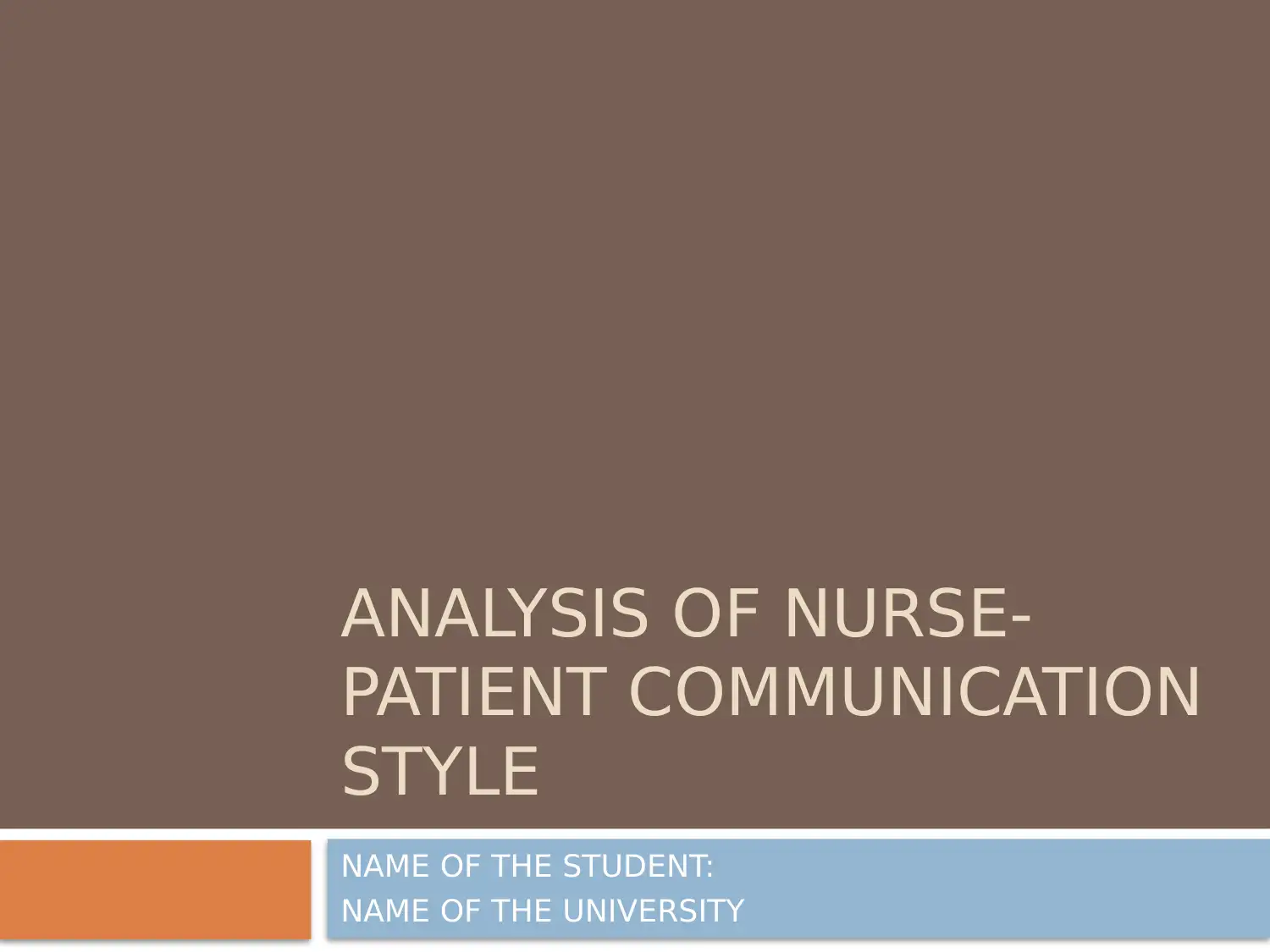
ANALYSIS OF NURSE-
PATIENT COMMUNICATION
STYLE
NAME OF THE STUDENT:
NAME OF THE UNIVERSITY
PATIENT COMMUNICATION
STYLE
NAME OF THE STUDENT:
NAME OF THE UNIVERSITY
Paraphrase This Document
Need a fresh take? Get an instant paraphrase of this document with our AI Paraphraser
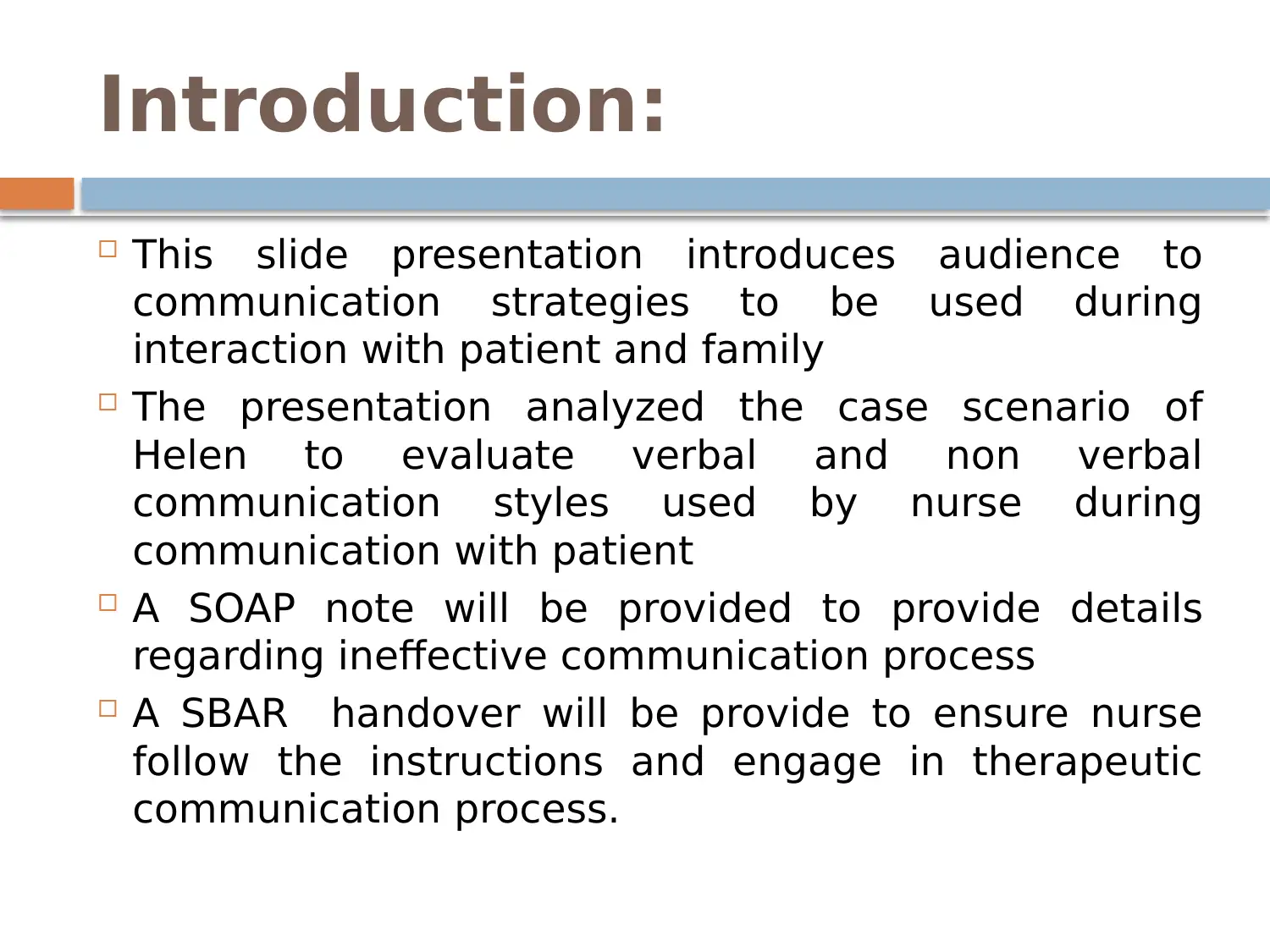
Introduction:
This slide presentation introduces audience to
communication strategies to be used during
interaction with patient and family
The presentation analyzed the case scenario of
Helen to evaluate verbal and non verbal
communication styles used by nurse during
communication with patient
A SOAP note will be provided to provide details
regarding ineffective communication process
A SBAR handover will be provide to ensure nurse
follow the instructions and engage in therapeutic
communication process.
This slide presentation introduces audience to
communication strategies to be used during
interaction with patient and family
The presentation analyzed the case scenario of
Helen to evaluate verbal and non verbal
communication styles used by nurse during
communication with patient
A SOAP note will be provided to provide details
regarding ineffective communication process
A SBAR handover will be provide to ensure nurse
follow the instructions and engage in therapeutic
communication process.
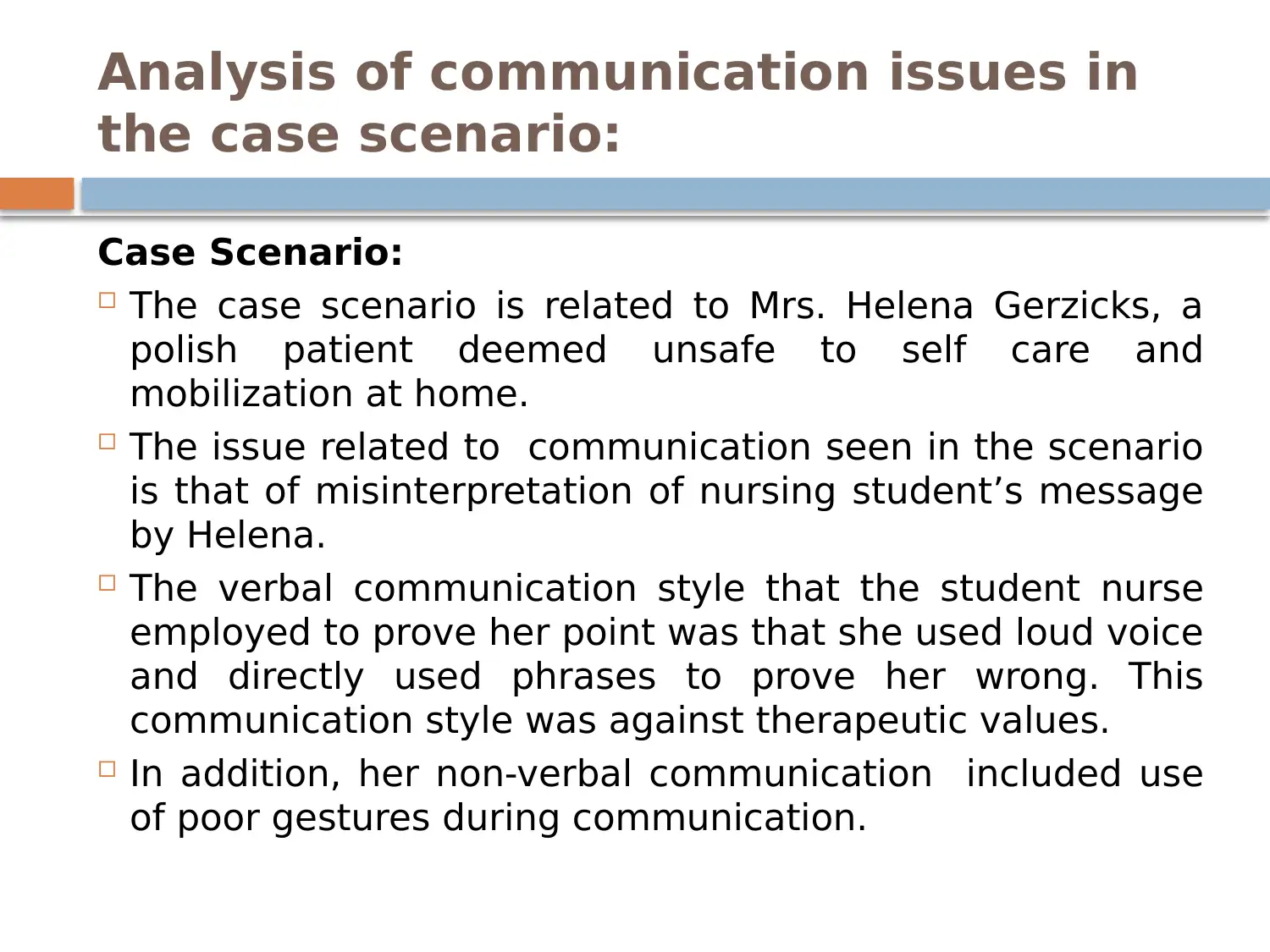
Analysis of communication issues in
the case scenario:
Case Scenario:
The case scenario is related to Mrs. Helena Gerzicks, a
polish patient deemed unsafe to self care and
mobilization at home.
The issue related to communication seen in the scenario
is that of misinterpretation of nursing student’s message
by Helena.
The verbal communication style that the student nurse
employed to prove her point was that she used loud voice
and directly used phrases to prove her wrong. This
communication style was against therapeutic values.
In addition, her non-verbal communication included use
of poor gestures during communication.
the case scenario:
Case Scenario:
The case scenario is related to Mrs. Helena Gerzicks, a
polish patient deemed unsafe to self care and
mobilization at home.
The issue related to communication seen in the scenario
is that of misinterpretation of nursing student’s message
by Helena.
The verbal communication style that the student nurse
employed to prove her point was that she used loud voice
and directly used phrases to prove her wrong. This
communication style was against therapeutic values.
In addition, her non-verbal communication included use
of poor gestures during communication.
⊘ This is a preview!⊘
Do you want full access?
Subscribe today to unlock all pages.

Trusted by 1+ million students worldwide
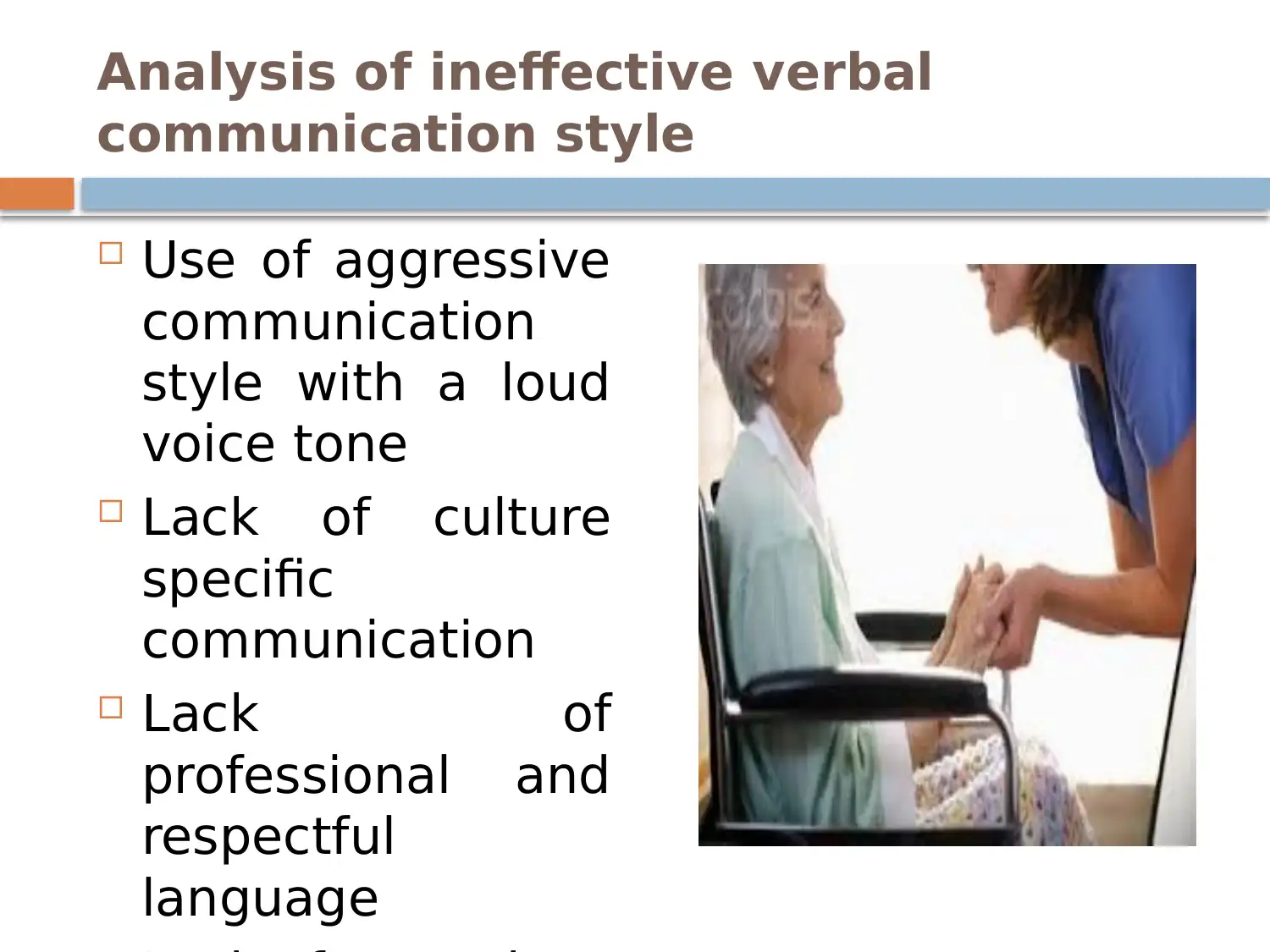
Analysis of ineffective verbal
communication style
Use of aggressive
communication
style with a loud
voice tone
Lack of culture
specific
communication
Lack of
professional and
respectful
language
communication style
Use of aggressive
communication
style with a loud
voice tone
Lack of culture
specific
communication
Lack of
professional and
respectful
language
Paraphrase This Document
Need a fresh take? Get an instant paraphrase of this document with our AI Paraphraser
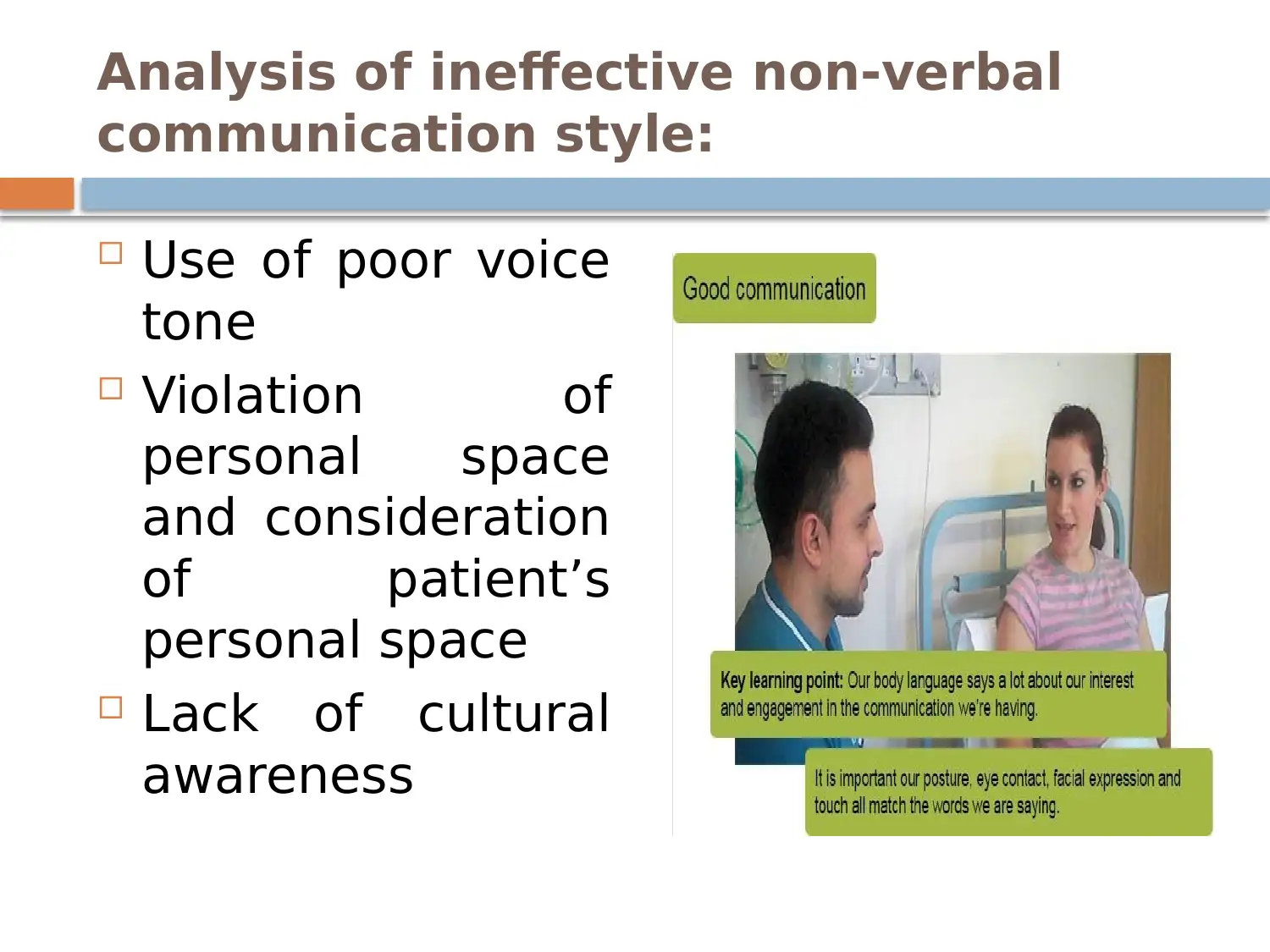
Analysis of ineffective non-verbal
communication style:
Use of poor voice
tone
Violation of
personal space
and consideration
of patient’s
personal space
Lack of cultural
awareness
communication style:
Use of poor voice
tone
Violation of
personal space
and consideration
of patient’s
personal space
Lack of cultural
awareness
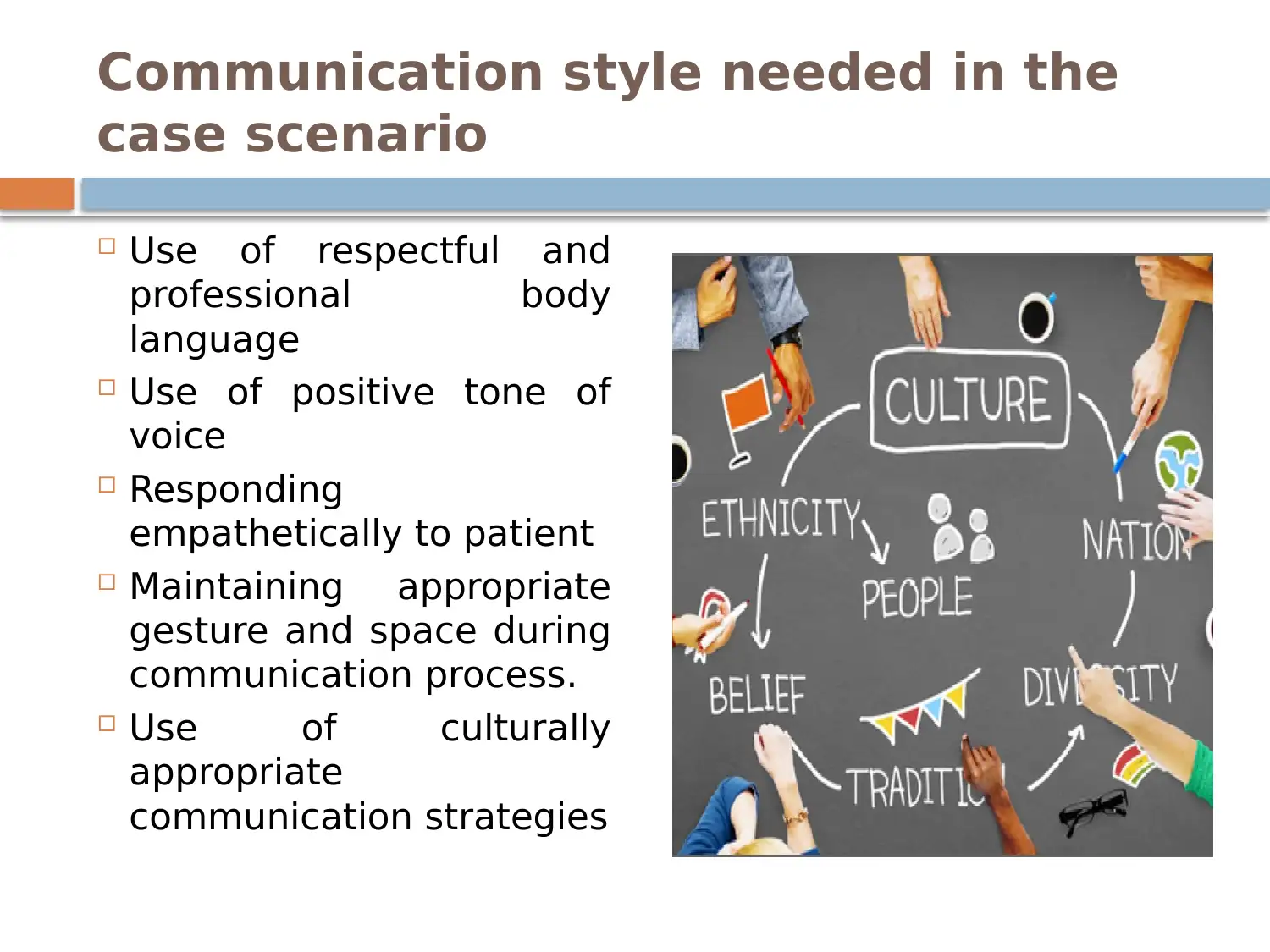
Communication style needed in the
case scenario
Use of respectful and
professional body
language
Use of positive tone of
voice
Responding
empathetically to patient
Maintaining appropriate
gesture and space during
communication process.
Use of culturally
appropriate
communication strategies
case scenario
Use of respectful and
professional body
language
Use of positive tone of
voice
Responding
empathetically to patient
Maintaining appropriate
gesture and space during
communication process.
Use of culturally
appropriate
communication strategies
⊘ This is a preview!⊘
Do you want full access?
Subscribe today to unlock all pages.

Trusted by 1+ million students worldwide
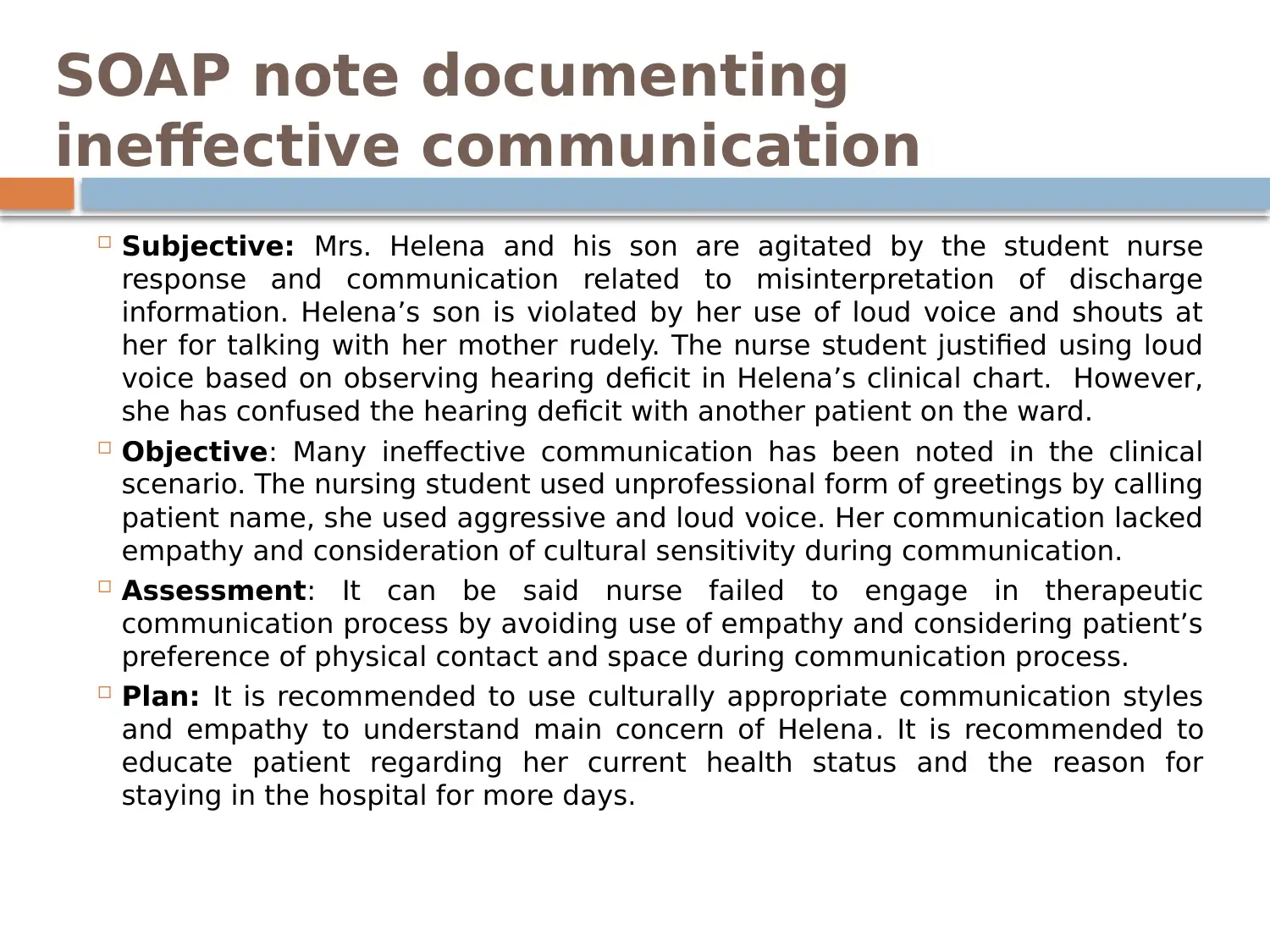
SOAP note documenting
ineffective communication
Subjective: Mrs. Helena and his son are agitated by the student nurse
response and communication related to misinterpretation of discharge
information. Helena’s son is violated by her use of loud voice and shouts at
her for talking with her mother rudely. The nurse student justified using loud
voice based on observing hearing deficit in Helena’s clinical chart. However,
she has confused the hearing deficit with another patient on the ward.
Objective: Many ineffective communication has been noted in the clinical
scenario. The nursing student used unprofessional form of greetings by calling
patient name, she used aggressive and loud voice. Her communication lacked
empathy and consideration of cultural sensitivity during communication.
Assessment: It can be said nurse failed to engage in therapeutic
communication process by avoiding use of empathy and considering patient’s
preference of physical contact and space during communication process.
Plan: It is recommended to use culturally appropriate communication styles
and empathy to understand main concern of Helena. It is recommended to
educate patient regarding her current health status and the reason for
staying in the hospital for more days.
ineffective communication
Subjective: Mrs. Helena and his son are agitated by the student nurse
response and communication related to misinterpretation of discharge
information. Helena’s son is violated by her use of loud voice and shouts at
her for talking with her mother rudely. The nurse student justified using loud
voice based on observing hearing deficit in Helena’s clinical chart. However,
she has confused the hearing deficit with another patient on the ward.
Objective: Many ineffective communication has been noted in the clinical
scenario. The nursing student used unprofessional form of greetings by calling
patient name, she used aggressive and loud voice. Her communication lacked
empathy and consideration of cultural sensitivity during communication.
Assessment: It can be said nurse failed to engage in therapeutic
communication process by avoiding use of empathy and considering patient’s
preference of physical contact and space during communication process.
Plan: It is recommended to use culturally appropriate communication styles
and empathy to understand main concern of Helena. It is recommended to
educate patient regarding her current health status and the reason for
staying in the hospital for more days.
Paraphrase This Document
Need a fresh take? Get an instant paraphrase of this document with our AI Paraphraser
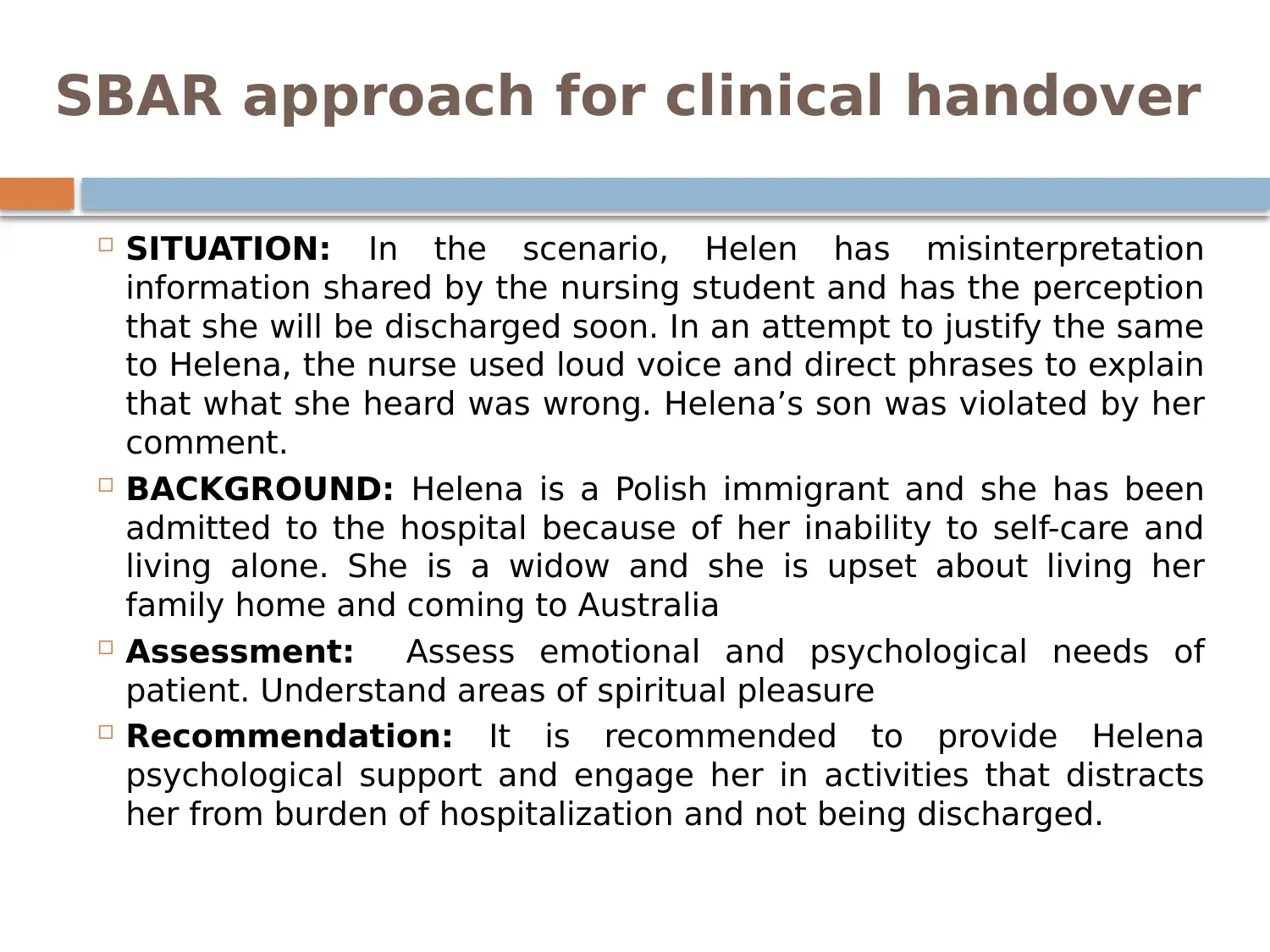
SBAR approach for clinical handover
SITUATION: In the scenario, Helen has misinterpretation
information shared by the nursing student and has the perception
that she will be discharged soon. In an attempt to justify the same
to Helena, the nurse used loud voice and direct phrases to explain
that what she heard was wrong. Helena’s son was violated by her
comment.
BACKGROUND: Helena is a Polish immigrant and she has been
admitted to the hospital because of her inability to self-care and
living alone. She is a widow and she is upset about living her
family home and coming to Australia
Assessment: Assess emotional and psychological needs of
patient. Understand areas of spiritual pleasure
Recommendation: It is recommended to provide Helena
psychological support and engage her in activities that distracts
her from burden of hospitalization and not being discharged.
SITUATION: In the scenario, Helen has misinterpretation
information shared by the nursing student and has the perception
that she will be discharged soon. In an attempt to justify the same
to Helena, the nurse used loud voice and direct phrases to explain
that what she heard was wrong. Helena’s son was violated by her
comment.
BACKGROUND: Helena is a Polish immigrant and she has been
admitted to the hospital because of her inability to self-care and
living alone. She is a widow and she is upset about living her
family home and coming to Australia
Assessment: Assess emotional and psychological needs of
patient. Understand areas of spiritual pleasure
Recommendation: It is recommended to provide Helena
psychological support and engage her in activities that distracts
her from burden of hospitalization and not being discharged.
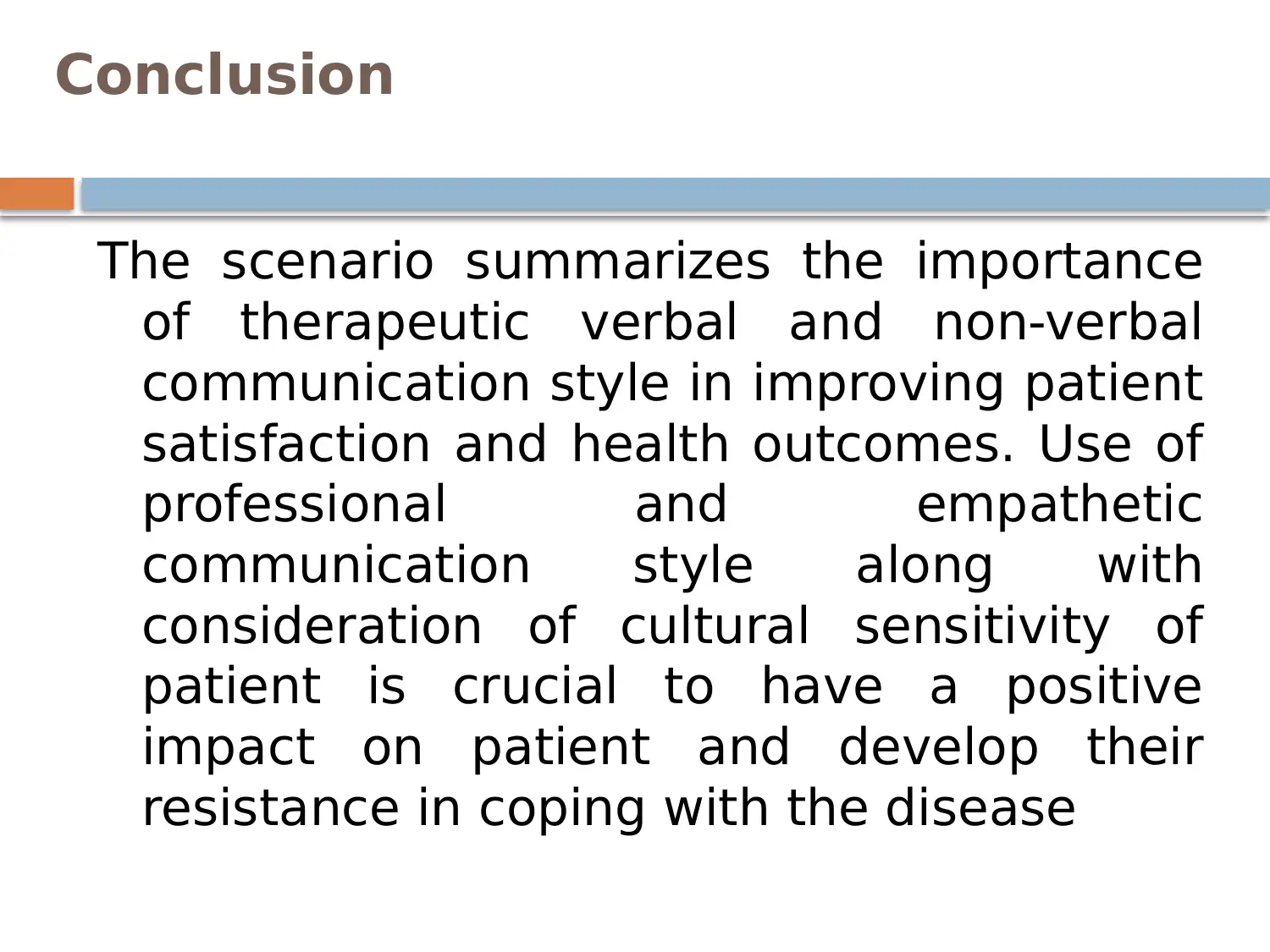
Conclusion
The scenario summarizes the importance
of therapeutic verbal and non-verbal
communication style in improving patient
satisfaction and health outcomes. Use of
professional and empathetic
communication style along with
consideration of cultural sensitivity of
patient is crucial to have a positive
impact on patient and develop their
resistance in coping with the disease
The scenario summarizes the importance
of therapeutic verbal and non-verbal
communication style in improving patient
satisfaction and health outcomes. Use of
professional and empathetic
communication style along with
consideration of cultural sensitivity of
patient is crucial to have a positive
impact on patient and develop their
resistance in coping with the disease
⊘ This is a preview!⊘
Do you want full access?
Subscribe today to unlock all pages.

Trusted by 1+ million students worldwide
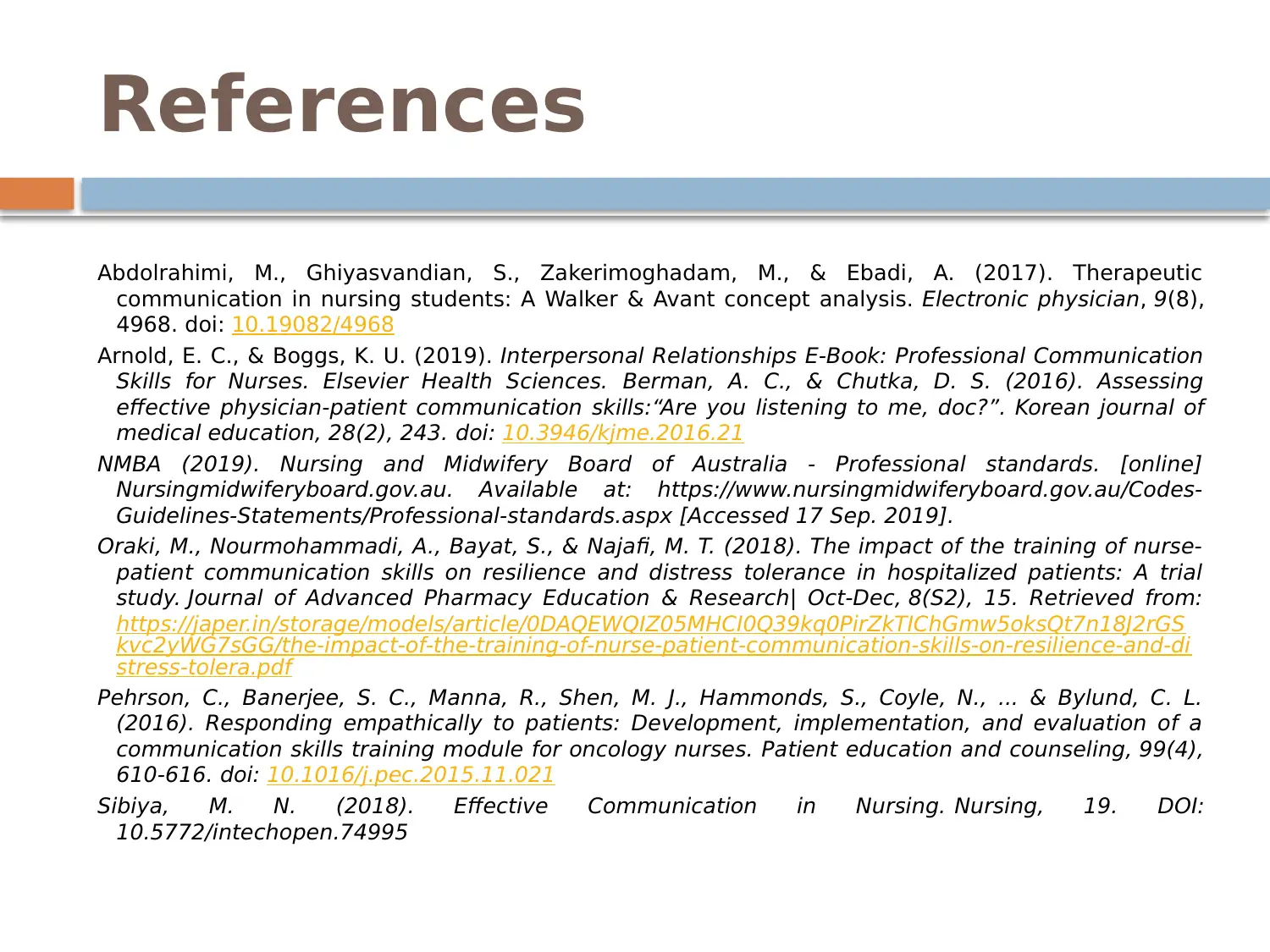
References
Abdolrahimi, M., Ghiyasvandian, S., Zakerimoghadam, M., & Ebadi, A. (2017). Therapeutic
communication in nursing students: A Walker & Avant concept analysis. Electronic physician, 9(8),
4968. doi: 10.19082/4968
Arnold, E. C., & Boggs, K. U. (2019). Interpersonal Relationships E-Book: Professional Communication
Skills for Nurses. Elsevier Health Sciences. Berman, A. C., & Chutka, D. S. (2016). Assessing
effective physician-patient communication skills:“Are you listening to me, doc?”. Korean journal of
medical education, 28(2), 243. doi: 10.3946/kjme.2016.21
NMBA (2019). Nursing and Midwifery Board of Australia - Professional standards. [online]
Nursingmidwiferyboard.gov.au. Available at: https://www.nursingmidwiferyboard.gov.au/Codes-
Guidelines-Statements/Professional-standards.aspx [Accessed 17 Sep. 2019].
Oraki, M., Nourmohammadi, A., Bayat, S., & Najafi, M. T. (2018). The impact of the training of nurse-
patient communication skills on resilience and distress tolerance in hospitalized patients: A trial
study. Journal of Advanced Pharmacy Education & Research| Oct-Dec, 8(S2), 15. Retrieved from:
https://japer.in/storage/models/article/0DAQEWQIZ05MHCI0Q39kq0PirZkTIChGmw5oksQt7n18J2rGS
kvc2yWG7sGG/the-impact-of-the-training-of-nurse-patient-communication-skills-on-resilience-and-di
stress-tolera.pdf
Pehrson, C., Banerjee, S. C., Manna, R., Shen, M. J., Hammonds, S., Coyle, N., ... & Bylund, C. L.
(2016). Responding empathically to patients: Development, implementation, and evaluation of a
communication skills training module for oncology nurses. Patient education and counseling, 99(4),
610-616. doi: 10.1016/j.pec.2015.11.021
Sibiya, M. N. (2018). Effective Communication in Nursing. Nursing, 19. DOI:
10.5772/intechopen.74995
Abdolrahimi, M., Ghiyasvandian, S., Zakerimoghadam, M., & Ebadi, A. (2017). Therapeutic
communication in nursing students: A Walker & Avant concept analysis. Electronic physician, 9(8),
4968. doi: 10.19082/4968
Arnold, E. C., & Boggs, K. U. (2019). Interpersonal Relationships E-Book: Professional Communication
Skills for Nurses. Elsevier Health Sciences. Berman, A. C., & Chutka, D. S. (2016). Assessing
effective physician-patient communication skills:“Are you listening to me, doc?”. Korean journal of
medical education, 28(2), 243. doi: 10.3946/kjme.2016.21
NMBA (2019). Nursing and Midwifery Board of Australia - Professional standards. [online]
Nursingmidwiferyboard.gov.au. Available at: https://www.nursingmidwiferyboard.gov.au/Codes-
Guidelines-Statements/Professional-standards.aspx [Accessed 17 Sep. 2019].
Oraki, M., Nourmohammadi, A., Bayat, S., & Najafi, M. T. (2018). The impact of the training of nurse-
patient communication skills on resilience and distress tolerance in hospitalized patients: A trial
study. Journal of Advanced Pharmacy Education & Research| Oct-Dec, 8(S2), 15. Retrieved from:
https://japer.in/storage/models/article/0DAQEWQIZ05MHCI0Q39kq0PirZkTIChGmw5oksQt7n18J2rGS
kvc2yWG7sGG/the-impact-of-the-training-of-nurse-patient-communication-skills-on-resilience-and-di
stress-tolera.pdf
Pehrson, C., Banerjee, S. C., Manna, R., Shen, M. J., Hammonds, S., Coyle, N., ... & Bylund, C. L.
(2016). Responding empathically to patients: Development, implementation, and evaluation of a
communication skills training module for oncology nurses. Patient education and counseling, 99(4),
610-616. doi: 10.1016/j.pec.2015.11.021
Sibiya, M. N. (2018). Effective Communication in Nursing. Nursing, 19. DOI:
10.5772/intechopen.74995
Paraphrase This Document
Need a fresh take? Get an instant paraphrase of this document with our AI Paraphraser

1 out of 11
Related Documents
Your All-in-One AI-Powered Toolkit for Academic Success.
+13062052269
info@desklib.com
Available 24*7 on WhatsApp / Email
![[object Object]](/_next/static/media/star-bottom.7253800d.svg)
Unlock your academic potential
Copyright © 2020–2025 A2Z Services. All Rights Reserved. Developed and managed by ZUCOL.





